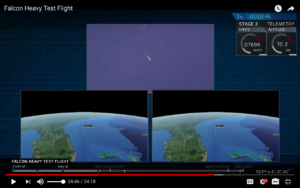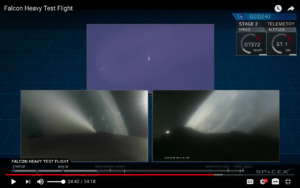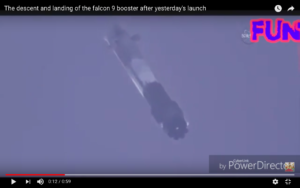Yesterday I mentioned to a friend that with my last post I’ve hung myself out on a bit of a limb – the clear message of the post was that Musk’s Falcon Heavy space shot was faked from the ground up, i.e., not only the ‘car in space’ footage but the launch itself. This is a helluva jump, notwithstanding that the physics says I’m right and the ‘witnesses’ wrong (if they claim they saw a real rocket take off and disappear into the heavens, with two other rockets descending to bulls eyes on the ground).
Let me quickly sum up why I must be right on this: I found and studied a video that purported to show the launch to the side booster separation and then the descent of the two boosters unedited, which of course does not mean it’s 100% reliable; but the overall look of the 8 or so minutes seemed legitimate. (And anyway, if they were faked, what does that say?) In hi-def you can see the boosters separate, turn around and head back west, whence they came. In hi-def you can see the flame/burn that accomplishes this, and you can clock the moment they cut off.
What you must understand is that from the burn cut off the boosters are falling objects, i.e., the only force acting upon them is gravity. (Please, flat earthers, just go away.) About 2 and a half minutes into free fall there is a six second burn, presumably to slow the descent (In most amateur videos it is absent; I’ve only seen one wherein it can be seen).
You want to see another outright lie? Look at the Spacex diagram to the left. See where it says ‘Aerodynamic Guidance’? ‘Guidance’? There is no guidance whatsoever in a free-falling object. Skydivers can form their bodies into a very crude airfoil and give the illusion of ‘flying,’ but what they are really doing is dropping like a fucking brick. (The guys with the ‘winged’ suits are a different matter; they have airfoils that generate some lift. There can be no lift in something the shape of a tube, like the boosters.)
The Grid Fins
In my last post I neglected to much describe the ‘grid fins’ (I added an addendum that most of you missed) but they deserve more detailed mention since they are the only theoretical aspects of the boosters that make them different from a falling brick or whatnot. Here’s Spacex’s description of the grid fins:
Falcon 9’s first stage is equipped with hypersonic grid fins which manipulate the direction of the stage’s lift during reentry. The fins are placed in an X-wing configuration and are stowed on ascent and deployed during reentry. While the fins are relatively small – they measure just 4 feet by 5 feet – they can roll, pitch, and yaw the 14-story stage up to 20 degrees in order to target a precision landing.
This is misleading, to say the least, since they can have no effect on ‘the direction of the stage’s lift during reentry’. The ‘stage’ (booster) has no lift whatsoever during its free fall. All it has is air-resistance, which – depending on its ‘attitude’ (or ‘uprightness’ – varies due to changes in terminal velocity, which itself depends on attitude (uprightness). The concept of terminal velocity deserves a trip to Wiki:
‘As the speed of an object increases, so does the drag force acting on it, which also depends on the substance it is passing through (for example air or water). At some speed, the drag or force of resistance will equal the gravitational pull on the object. At this point the object ceases to accelerate and continues falling at a constant speed called the terminal velocity (also called settling velocity). An object moving downward faster than the terminal velocity (for example because it was thrown downwards, it fell from a thinner part of the atmosphere, or it changed shape) will slow down until it reaches the terminal velocity. Drag depends on the projected area, here, the object’s cross-section or silhouette in a horizontal plane. An object with a large projected area relative to its mass, such as a parachute, has a lower terminal velocity than one with a small projected area relative to its mass, such as a bullet.'[end quote]
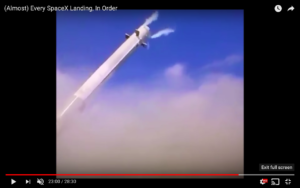
This crash on an earlier flight was blamed on the grid fins: Grid fins only work at hypersonic speeds! A Lie.
Obviously, the more ‘upright’ the booster, the faster the terminal velocity, since the up-rushing air strikes less of the body. Whether the ‘U-turn burn’ gave the boosters a ‘boost’ in their free-fall (the equivalent of being ‘thrown downwards’) is not mentioned but no one seems to doubt that the boosters were supersonic on the way down. Also, as the boosters descend, they will slow down in the denser air. Listen to this crapola from the Daily Mail (UK):
Speaking on the triple sonic boom given off by SpaceX craft as they land back on Earth, John Taylor, SpaceX’s Communications Director, told SpaceFlight Insider in 2016: ‘[The] first boom is from the aft end (engines), second boom is from the landing legs at the widest point going up the side of the rocket, third boom is from the fins near the forward end.’
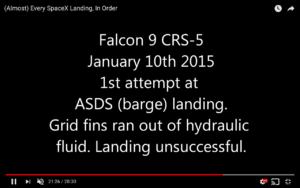
This was onscreen just before the previous, of the crash. This is all PR so you will accept the bullshit to come.
This makes little sense (as quoted) except to verify supersonic speeds, which is my only purpose subjecting you to it: We can assume the boosters were supersonic for most of the way down. Keep that in mind as we return to the ‘grid fins’ for a moment. All they can do is ‘… roll, pitch, and yaw the 14-story stage up to 20 degrees in order to target a precision landing.’ The ‘target a precise landing’ is likewise misleading (if not an outright lie) since the grid fins can have no direct effect on trajectory. Also, remember this: ‘…equipped with hypersonic grid fins…’ This means that the fins only have effect at hypersonic speeds – ‘hypersonic’ means above mach 5. Since at no time during their descent were the boosters hitting mach 5, Spacex’s own words tell us that they were useless during their free fall descent. But let’s even put that aside.
[Addendum: I’m subjecting you to all these details (some redundant from my last post) because we are assuming that ‘extraordinary claims require extraordinary proofs.’ I have an extraordinary claim to make: Whatever ‘thousands of witnesses saw/photographed,’ it was not as claimed. In fact, whatever was seen/filmed was almost certainly not real, solid matter. It was an illusion. Okay? So hang in with me here.
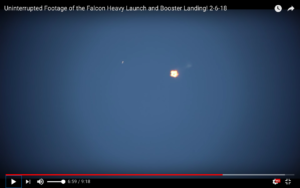
One booster started its ‘re-entry’ burn a second before the other. Just one of the many factors that make a simultaneous landing impossible.
‘What about the rocket engine?’ you might reply, referring to how the boosters adjusted their fall to make pinpoint landings after something close to 54 miles of uncontrolled ‘flight.’ Okay, listen: In the final burn before touchdown, watch the ‘onboard’ cameras: they show the bulls eyes dead on right below the boosters, right? So the final burn had no effect on the pinpoint accuracy. The only other burn during free fall was for 6 seconds at about 2 and a half minutes after free fall began and about a minute and a half before landing. These burns only affected gravity’s force, i.e., slowed the descent; there was no perceptible lateral movement, nor could there have been more than a tiny amount, if the jet nozzles were tilted one way or another.
Back of the envelope calculation gives us a speed of, say, 800 mph (just above mach 1) for about four minutes of free fall (as timed from the video), which equals 54 miles distance traveled downward. (This need not be pinpoint accurate for my purposes.)
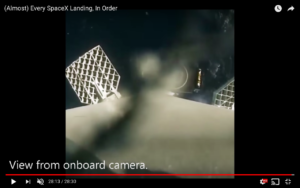
The fins are for show only: they have no effect whatsoever at slow speeds. (The ‘target’ is already right below, so the final burn was to slow descent, not to alter trajectory.)
I have no argument that the ‘return burn’ after separation put the boosters ‘right over’ the bulls eye down below. But, as mentioned in my last post, those 54 miles of free fall were through some of the least predictable (because there’s no constant measurement) and highest winds on the planet. (Winds in the stratosphere have been clocked at 300 mph.)
You can’t back up a rocket like you do a car!
Once you really understand that my analogy (last post) that the twin booster landing was doubly impossible – hitting the bulls eyes and doing it with two projectiles simultaneously – you’re well on your way to accepting the truth that the PTB now have maybe complete control over what you see ‘with your own eyes.’
Allan
Please keep an eye out for any non-flat earth ‘alt media’ outlets that have told you the truth about Spacex, as I have. If you can’t find anyone, ask yourself why not?

